MA Eco-Social Design: Project 2 by Giorgio Groß | SS 2021
Airshop. The lightweight shop system for creative minds that puts people and planed first
We enable creative minds and sustainable brands to build their business on trust, transparency and authenticity. With Airshop, brands can show their customers what’s behind their products, and how they impact our world.
text
At Airshop, we believe that creative minds and sustainable brands make a difference in our world — and it is our job to ensure those innovators are seen and supported across the globe. We build Airshop for those who dare to follow their passion and create beautifully designed and responsibly crafted goods. Airshop is the stage where these people and brands can express themselves, show what they stand for, and sell to the right customers.
 Online-shops based on videos and live streams
Online-shops based on videos and live streams
We are building an e-commerce platform that unleashes the full potential of creative minds by eliminating the boundaries of conventional shopping platforms. We put the people who stand behind a product first, and we emphasise creating goods in harmony with the environment.
By deeply integrating these two formats into our shopping experience, brands can show their impact, explain how a product is made, and ultimately sell their works to customers who value them for their sustainable practices.
Competing in transparency instead of price
We give customers deep insights into the production process, and thus open up a whole new field of competition. Buyers now understand the real value of a product and see the environmental and social impact of their potential purchase.
The Research and Design Process
Initially, my project’s goal was quite a bit different from what it is now. I asked myself: What is necessary to enable a carbon-negative economy? How can I support creative people to create their own, independent, local brand which earns them their living while also creating a carbon-negative economy? These questions started my journey through three iterations of my project proposal, which I summarized in the following. This documentation follows the design research loop’s structure as presented by Seçil Ugur Yavuz, What is Design Research?, and describes each iteration’s exploration, ideation, prototyping, testing and reflection phase sequentially.

Preliminary Research: Getting to know the issues
I contacted about 50 design brands early on in my process to learn about their work and which problems they face. Of those, I got feedback from roughly 15 and kept working with a hand full of designers and artisans as partners and stakeholders until today. I broke down my initial questions and formulated the following three main research questions that I could answer by extracting explicit knowledge (Yavuz, Getting Embodied & Tangible in Design Research, 2021):
- What are the biggest challenges for designers to create a sustainable business and to compete with drop shippers and large-scale manufacturers?
– Time to market: Big players can bring products to market faster.
– Availability: Big players have always stuff in stock and storage available.
– Reaching the right audience: Some people prefer personal items over mass produced ones, but they are hard to reach for new/small brands.
– Technology: High end production line, analytics, online presence, powerful ecommerce are missing and access to established manufacturing lines is hard because of low order volumes. - What are the biggest challenges for designers to create their individual brand?
– Financing: Producing upfront needs a lot of money and producing on demand requires longer delivery time and efficient processes.
– Reaching and selling to customers: Web presence, selling through own store (e-commerce) is a challenge, shop-systems are hard to understand and thus a lot of time is needed to get into this topic, a lot of shop systems have a big operational overhead. Sales and marketing channels are missing.
– Production & fulfillment: A lot of designers partner with service providers, e.g. carpenters (revenue split 15% designer, 85% carpenter) and retail shops, e.g. furniture shops (take again 5%) to produce and sell. Some designers have their own mini-workshop and prefer to build their products on their own. Some designers want to outsource this and could need a manufacturing line. - What do independent designers want to achieve with their business?
– Build a side business for extra income.
– Build a recognizable brand.
– Making a living while keeping ones values.
– Follow their entrepreneurial endeavors and their „just build things“ attitude.
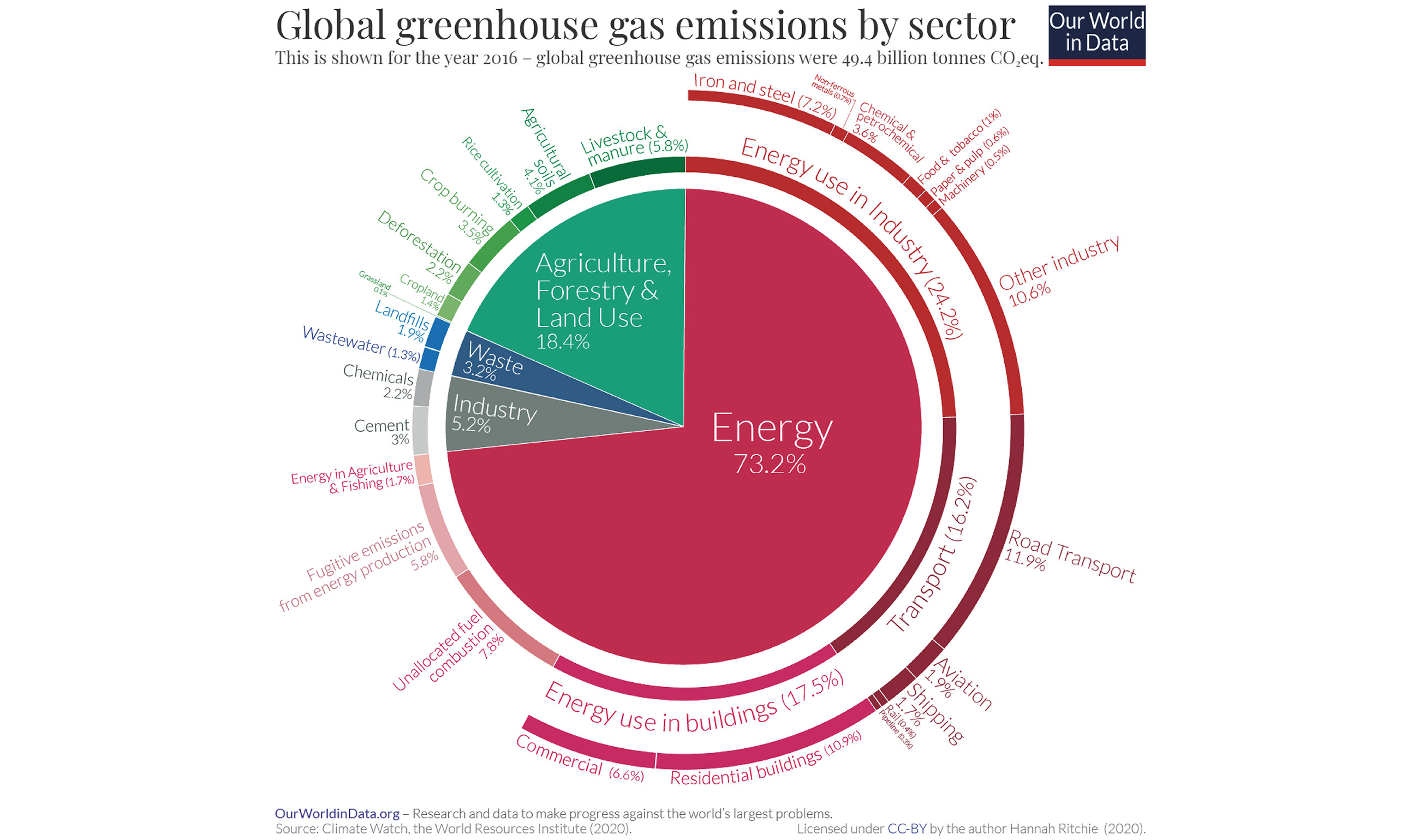 To figure out how to solve the emissions problem, I started to do more desk research on the sources of greenhouse gas (GHG) emissions and their causes. An analysis (OurWorldInData, 2020) showed that the biggest part of emissions stem from the energy sector. More research on (Carbonbrief, 2020) and (Statista, 2021) showed that the furniture industry only makes up a tiny part of the global emissions. Nonetheless, this project aims at building a foundation for a larger impact and as I need to start somewhere I decided to stick with end-consumer products and, for now, focus on the furniture market.
To figure out how to solve the emissions problem, I started to do more desk research on the sources of greenhouse gas (GHG) emissions and their causes. An analysis (OurWorldInData, 2020) showed that the biggest part of emissions stem from the energy sector. More research on (Carbonbrief, 2020) and (Statista, 2021) showed that the furniture industry only makes up a tiny part of the global emissions. Nonetheless, this project aims at building a foundation for a larger impact and as I need to start somewhere I decided to stick with end-consumer products and, for now, focus on the furniture market.
Another research by (L. Linkosalmi et al., 2016) showed that materials contribute 38-90%, production 8-58% and delivery 1-8% to the emissions expelled during the production of furniture. So a good point to start would be to minimize the use of materials from our environment, switch to recycled or upcycled materials and base the production on renewable energies.
I added a case study of the Waya Collective to my research (Lorenz, 2021) who already builds a fulfilment infrastructure for organic cotton based fashion products in Africa. In their case, they have a very specific target customer and focus more on manufacturing than on building a circular economy. Still, the founder Antonia Lorenz demonstrated that it’s possible to build a network if we focus on clearly on certain actors.
Assessing risks, feedback and outcomes
Because of the complexity and high risks, I decided to skip the prototyping and testing phase, relied on feedback of my partners and reflected on the idea: Obviously, this approach relies heavily on a big network that’s potentially hard to build. Also, some materials need reservations of several months, as Nusen’s Simon Korazija told me. Ecologically produced high quality wood is one example here. Silvan Glorie further explained how hard it is to acquire a special material for certain products, and that getting the providers into this network would be another challenge.
Engaging and connecting all the players to cooperate instead of driving them to compete with each other poses another challenge, and also sourcing all the materials necessary for future demands will not be easy.
All of the mentioned problems are linked to network problems: The network unfolds its power the more people are in it, and as long as there is no one in the network, no one sees the need to join. Put in other words, members of this network get no immediate benefits.
Hence, I tried to iterate my idea to find a project that can be created and validated quicker, has less risks and solves a more tangible problem.
One thing that always struck me during my research was how hard it is to find information about the environmental impact of a product. Customers have far too less insights and information to decide which brand takes responsibility for the environment, and it’s hard to see the actual social and environmental price of a product. So I looked into this topic for my second iteration.
Assessing the production and life cycle of products
I found research on the global warming potential of wood-based products by S. González-García et al. (S. González-García et al., 2011). The paper suggests to do a life cycle assessment (LCA) and combine it with design for the environment (DFE) in order to understand and reduce the product’s GHG emissions. I made an example LCA for a skateboard in IMG8 to get a better feeling for the information.
I also followed along furniture products through their production process and noted that customers hardly see anything of the story. Designers usually put a lot of effort into their designs, and responsible brands try to manufacture it without harming the environment. Yet, customers can only see a small fraction of the whole process in the form of the final product.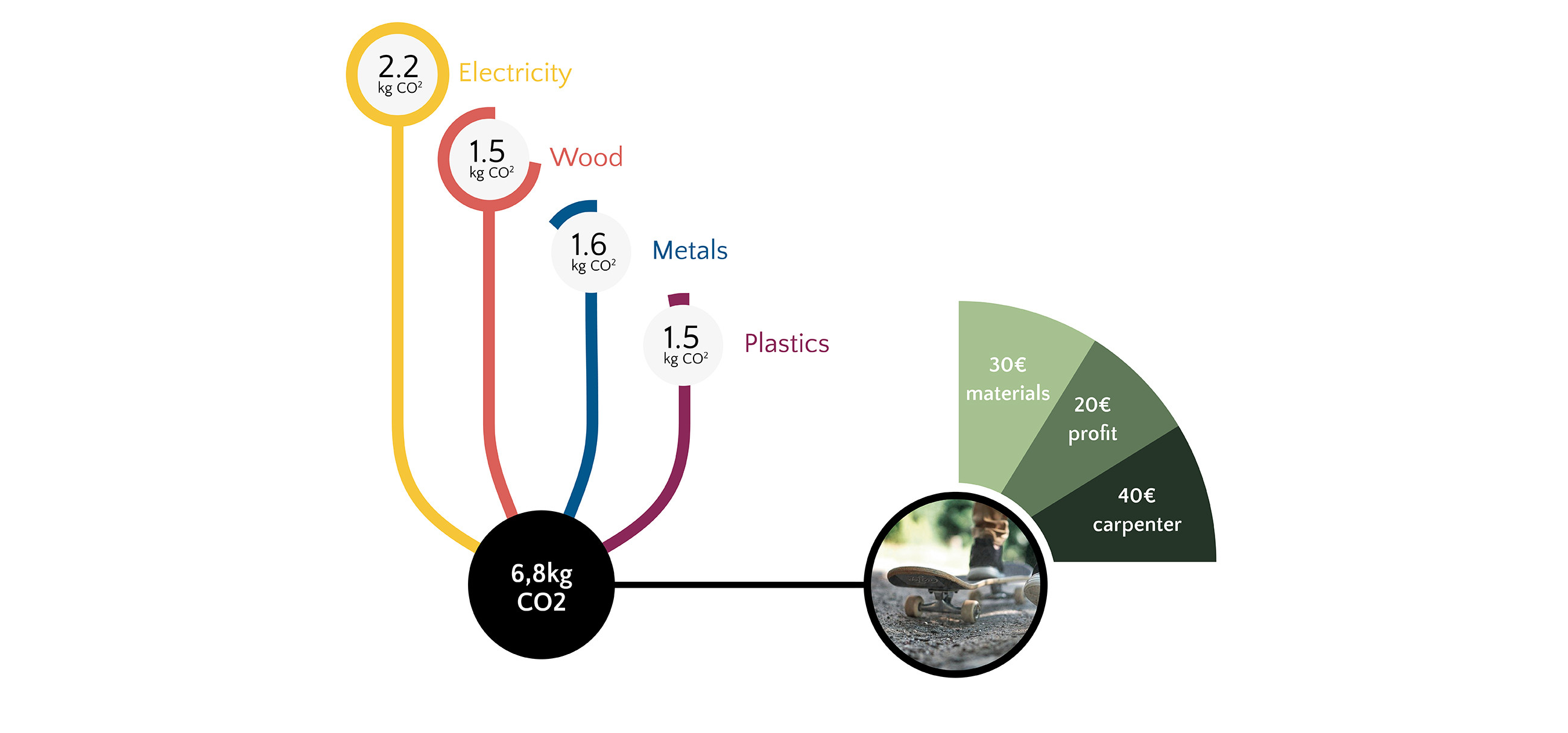 Making the story visible
Making the story visible
I involved two of my partners, Sabine and Wilfried Schönbohm, closer in the process and explored ways to convey the story of a product. I want to point out that at this point my friend and partner Daniel Schönbohm fully joined this project as a co-creator and reserves at least as much recognition for the final outcome as me.
Eventually, we came up with the idea to record videos and create a visual one to two minute summary of the whole process. Together with the Schönbohm family, we co-created the first snippets in their ceramics atelier and their metal workshop by following the co-design principles:
- Consent driven: Content and format were clarified with our partners to match their interests.
- Visual and creative: The videos were recorded with a common goal in mind, but allowed them to freely explore the possibilities of this medium. I created an initial video with stock photography to inspire them and left the stage for them to record the things they wanted to show.
- Embodied: My partners were encouraged to follow their usual production habits. Also, the feelings that the video triggered were really important to me when we watched small compilations. This was an on-site process and helped us to quickly find the right perspectives for our recordings. The choice of music turned out to further affect the perception of the content.
- Connected to a place: The content should strongly relate to themselves, their brand and their workshop. We wanted to capture their personality and how they work, and found that integrating their values into the visuals made the video much more authentic.
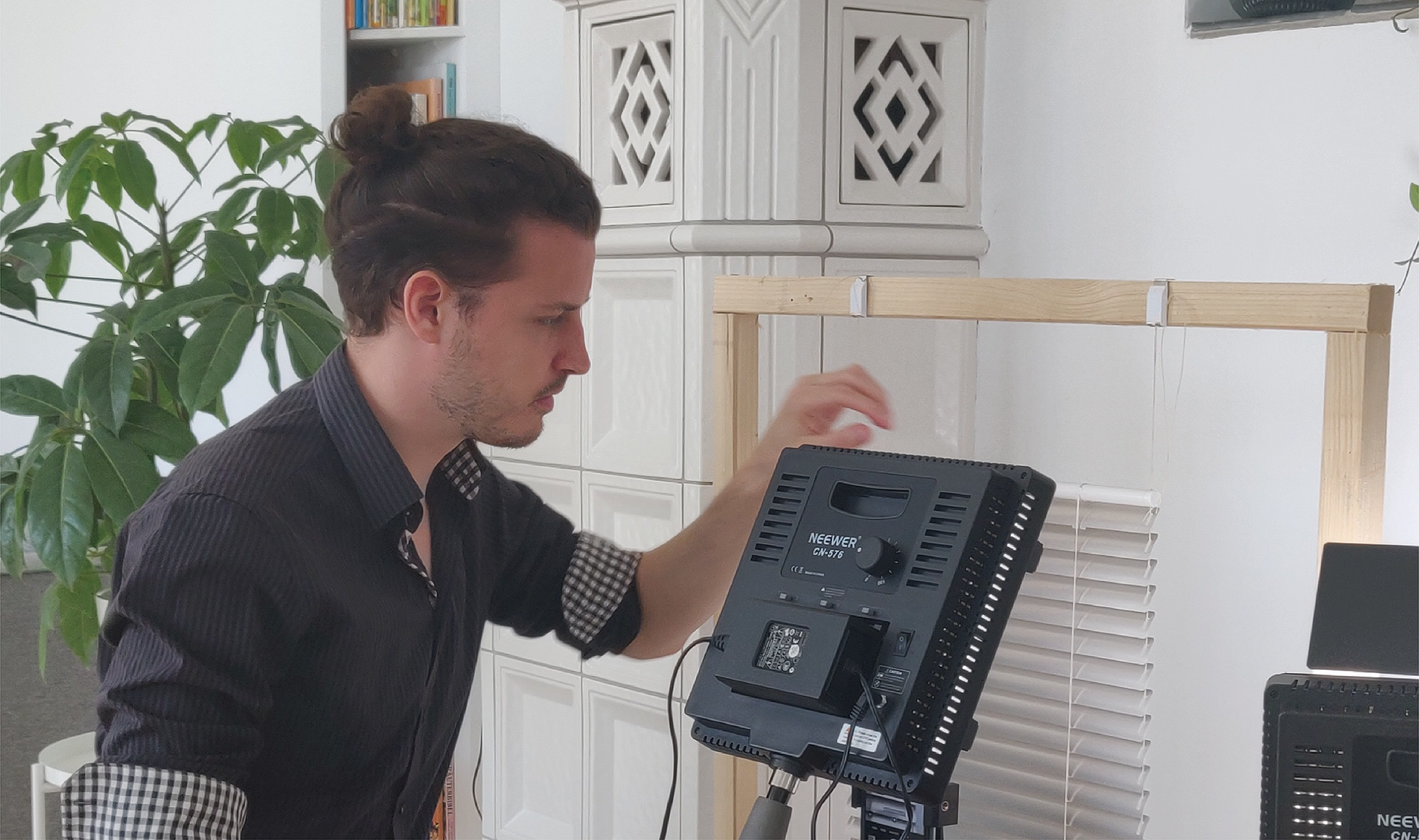
We made classical co-design loops with quick actions and fails, and eventually ended up with pretty good content after the third iteration. Creating the videos with our partners not only produced interesting content, but also allowed us to extract more tacit knowledge. During recording, we were able to derive what matters to them, their hopes, pain points, and feelings about their work, about themselves and about our activities.
Creating and distributing the final videos
Testing actually already started when we met with our partners to record the videos, as we needed to find out how to record good clips with a smartphone and combine them into interesting summaries. I then created a small web site where visitors can watch and explore the videos and view more information about the product, such as which materials were used or who the producer is.
We showed the page to a couple of friends, to our partners and to the professors responsible for the current semester projects coordination. The videos demonstrated that it is possible to tell the story of a brand or of a product within a short amount of time, to create good videos with nothing but your phone and a daylight lamp, and to spike interest in the brand and in the product across viewers.
What are we solving?
Taking the idea of videos a bit further, we can introduce context information such as emissions, water usage, or involved people and embed this information either as an overlay or by actually recording scenes that convey the information. Doing a LCA for the products will still be a preliminary requirement, but we found a way to convey what’s behind a product, how the brand behind it operates, who produces it and which impact they have. Thus, short videos seem like the perfect medium to show the environmental and social impact of a brand, and to educate customers about the effects their potential purchases will have.
This surely does not reduce carbon emission in itself, but we can support people and companies which already work on reducing emissions, give them a stage where everyone can see them, and build valuable relationships that could allow us later to pivot towards my first proposal.
Yet, we were not fully convinced:
- The project lacks a business model.
- Creating these videos takes at least one day for a person, so their engagement needs an immediate return.
- A video sharing platform would introduce the traps of networks again.
Re-discovering long known issues
We reassessed our notes from the first two iterations and re-discovered that building a web store and driving sales is a major pain point of our partners. In turn, we are able to present them in the web through a medium that gives them limitless flexibility to present themselves and their brand, along with all the information needed for consumers. So why not combine online stores with videos to create a new way people shop? That way we not only solve the information problem on the customer side, but also the sales problem on the producer side.
Additional desk research showed that videos actually make sense in the context of online shops as a study by Animoto shows (Animoto, 2021). The Chinese market even took a step further where startups have successfully integrated live streams into the online shopping experience (Greenwald, 2020). Sadly, these approaches do not encourage a responsible consumption – something we believe videos and live streams are perfect for.
To get a better understanding of our partner’s needs, we made an ethnography research with two partners and followed them along when handling their current online shop systems. This allowed us to discover even more potentials how a lightweight online shopping system could look like and gave us important hints which features to include and how to prioritize them. To repeat it once again here: We are looking to create a tool that actually solves a problem of our partners. Just setting up a new selling technology won’t make their life easier, so we want to highly adapt it to their specific needs.
Reimagining online shopping
The revised concept built up on our previous iteration and extended the pages with interfaces to configure and shop the product shown in the video. We also added a page where visitors can see all the products of a seller, and created seller spaces where only the seller’s products are shown. For the UI, we experimented with different layouts but were mainly restricted by the portrait format of the videos. To improve understanding of context information, we ideated some options to present the results from life cycle assessments and made a demonstration in IMG8. The data was based on the previously mentioned papers to roughly estimate the footprint of a skateboard and served to explore different visuals.
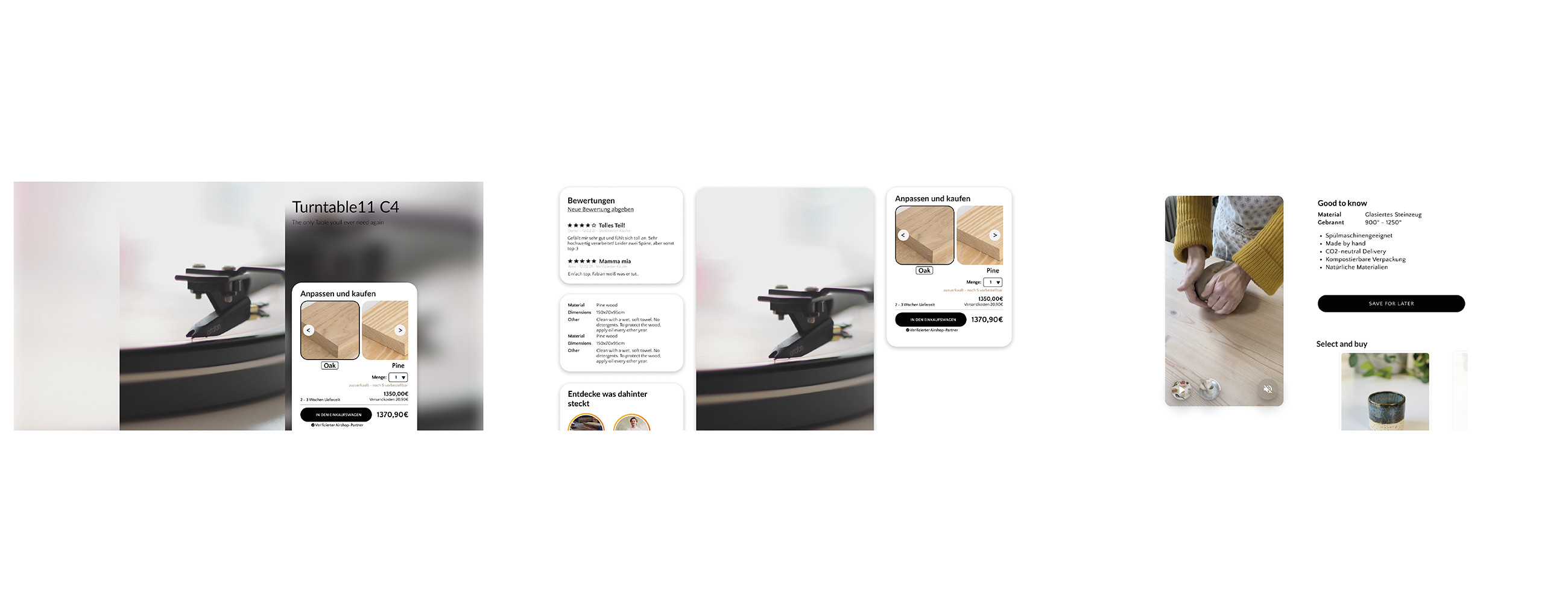
We added up on the video-based online shop by also imagining a live stream integration. Unlike the Chinese market, we consider this feature as very experimental in the European market and thus focus more on the video feature. Live streaming will be an important prospect for future research.
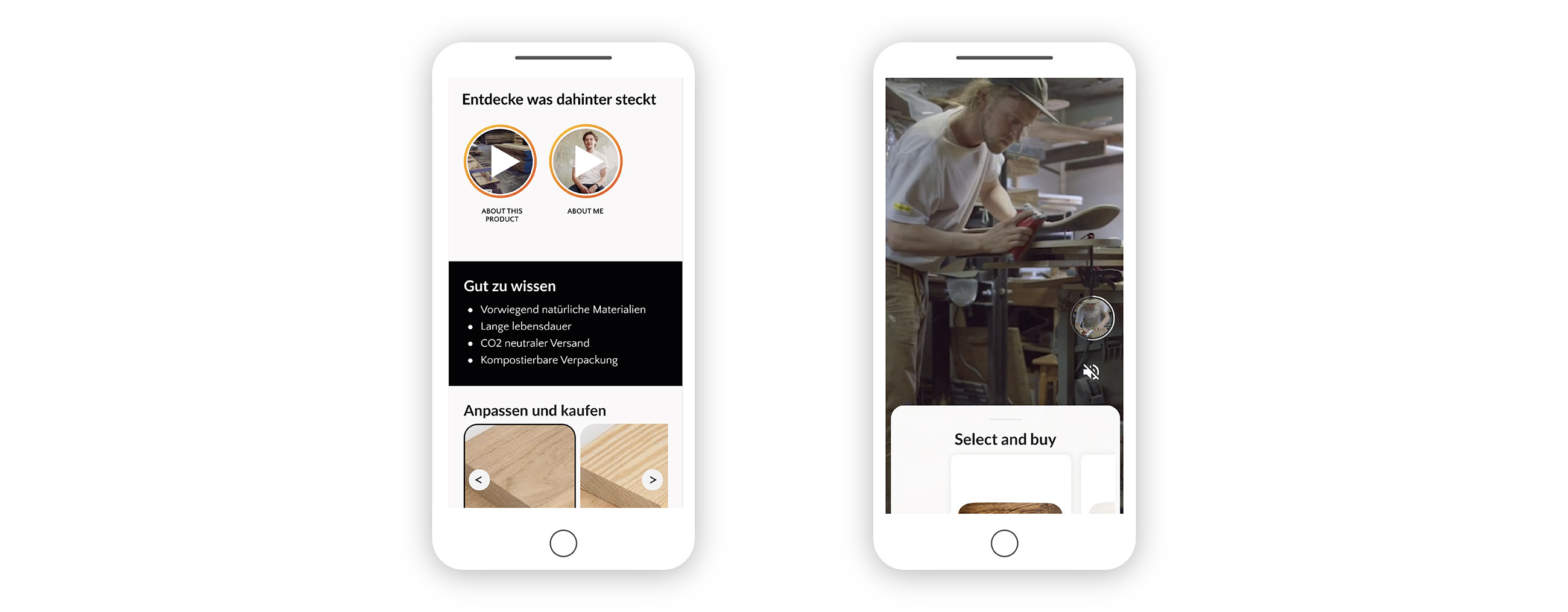
As we were now approaching our first public release, we developed concepts for a landing page. A pre-requisite of this task was to become clear who we want to target and what our values are. During longer brainstorming sessions the two of us elaborated on a shared objective, mindset and goal setting for Airshop and aligned the product with our values. Our product should become a technology for creative minds who craft goods in harmony with the environment. Therefore, we put these creators at our heart and create an environment where they can express themselves freely in the boundaries of social and environmental responsibility. By this time, we introduced the name “Airshop”, which relates to the lightness, ease and freedom: It’s intended to be a very simple, easy to use online shopping technology, much “lighter” than competitors like Shopify or Squarespace, and should give sellers freedom to express themselves as they wish. We will develop Airshop as a tool and all our actions, communication and funnels should exclusively target and promote sustainable brands. We also agreed on an initial commission-based business model for Airshop sellers, which should allow everyone to try Airshop without risk and will support us in building our own business.
Getting sellers online
We implemented the designs shown above on a sample page and embedded some videos to get a feeling for the platform. Our partners provided frequent feedback which allowed us to produce high quality dummies early on, but to validate the whole idea we needed to release a public version of our project.
More feedback from partners and friends revealed missing features, such as an option to save a product for later or more ways to customize a product, which we integrated promptly.
The next logical step was to turn the dummies into actual working online shops. We extended our code base, attached the page to a serverless environment and created data bases, structures, communication interfaces and other components necessary to power up an online store. As a payment provider, we chose PayPal and integrated their Business API into our page. Then, we added analytics and a proper cookie management along with required legal documents. Last but not least, we added an order processing logic which sends order and delivery confirmation mails to the buyer. During this process, we overcame many technological challenges and built the foundation for future product developments.
Customer adaption
Airshop’s first store is online for five days now and we could track 98 unique visitors so far and generated a small transaction flow for our partner. Sadly, one of our partners fell ill and could not publish the second store that we. We are looking forward to release her store as early as possible, and are now also extending our reach to convert more sellers to Airshop. Essentially, we expect this testing phase to be longer than the previous ones and we now start to focus more on engaging end customers.
Our partner agreed to spending money for payed advertisements which will drive more traffic on our site for validations. The following weeks will certainly give us more insights into the user behavior and allow for further validation.
Outcomes and next steps
We already have strong supporters on the seller side who actively use and trust Airshop, we were able to create all of the necessary infrastructure and technology as a team of two, and we are currently evaluating the first live version of Airshop. Yet, this is just the beginning of a larger project, and due to a lack of store visitors we are still unable to definitely tell how well our approach works. Therefore, our highest priority lies in attracting more companies to join Airshop and in supporting them to create more of the content that we built Airshop for.
Reflecting more on the kind of content that we feature through Airshop, one can conclude the following: Sustainable brands create videos which show the creation of a product, which materials were used, where they are coming from, who is involved in the production, and other perspectives on how the brand operates in our world. This increases transparency and authenticity and creates more trust among buyers. People can understand what’s behind the product, and can understand its real value, its price tag and the impact of their purchase. If they like what they see, they won’t buy that product from any other company and instead support the company whose video they just saw. In addition, the videos might inspire customers to pay more attention whenever they buy anything else, and to consider what they really need to have. Overall, Airshop sellers can raise awareness for environmental and social impact and drive customers to a more responsible way of consumption.
To help brands to already raise awareness, we started a series of articles which tell the story of the brand. The articles are aimed to put sustainable companies and their founders in the spotlight and to inspire other makers and brands to follow suit. This as also part of our acquisition channel, as we can add content to our site, build relationships with other brands and attract founders who might be a good fit for Airshop. We have already the first articles online on our blog - ironically, interviewing the brands for the article gave us even more insights into their workflow and allowed us to learn even more about their problems and future potentials for Airshop.
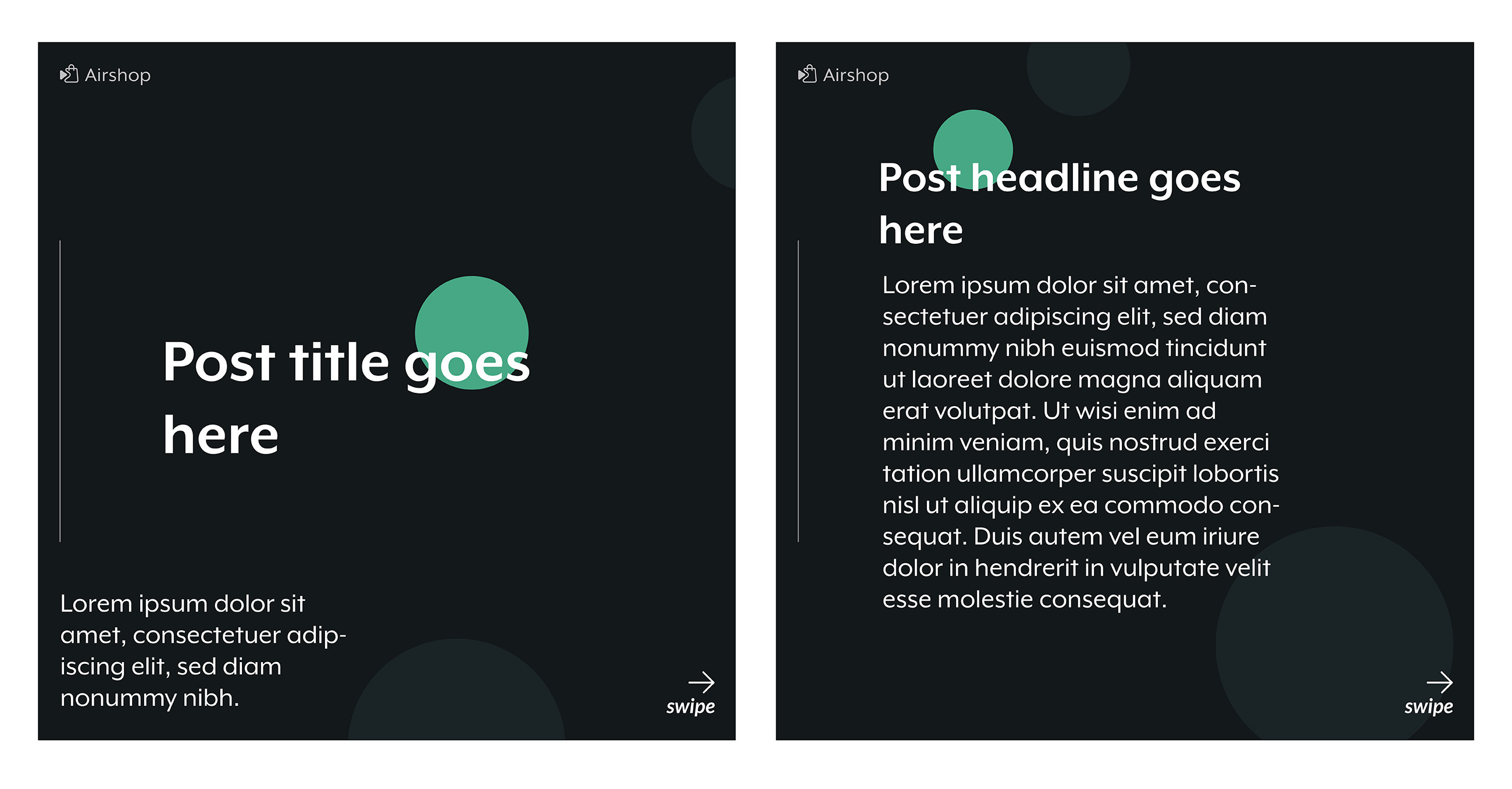
This also affects our appearance on social media channels, which is why we set up various formats and contents to be published on Instagram. Essentially, we have formats to share knowledge, formats to announce new sellers and formats to feature brands we wrote about in our articles.
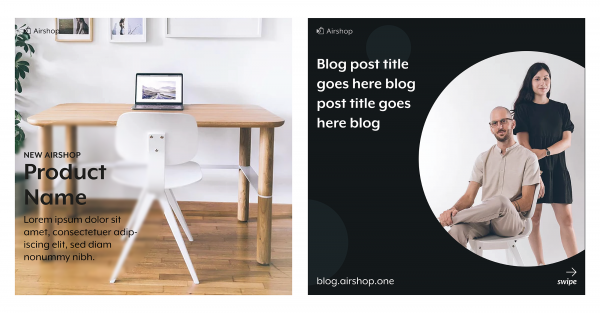
As our concept got more tangible over time, we also needed to revise how we coordinate and work within our team. We now use the tool Notion for online collaboration and set up a workspace structure, which allows us to efficiently work on tasks simultaneously or complementary. Our structure also serves to keep track of all sellers, potential sellers, competitors, feature requests, technologies and operational details. We noted down also a written form of our values and work ethics to lay the foundation for a healthy company culture, which we will have to keep refining once our team starts growing.
Wrapping it up
We have spent more than half of the semester trying to understand the actual problem of our target group. In retrospect, we started out with a tiny group of people that we just wanted to succeed, and connected to them during our first two iterations. We examined their workflow, their pain points, and their wishes to really understand them, the market and the competitive landscape. Wo combined the outcomes with more research on environmental issues and identified several potentials for future products, which both solve severe problems of our target group and benefit the environment. However, we always made sure to move quickly from one idea to the next without fully implementing the first one or even polishing the edges. This allowed us to quickly explore and iterate three proposals and gave us many valuable insights into future potentials. Our design process led us to finally come up with Airshop, end still helps us to tackle our current challenges.
text
Students:
Giorgio Groß
Teaching Team:
David Calas (Object–Spaces–Services)
Kris Krois (Communication–Interaction–Services)
Secil Ugur Yavuz (Design Research)
Marie Beuthel (Social Interaction Design)
Partner:
Daniel Schönbohm
Keramikatelier Sabine
Umbratec Systems GmbH
Supporters & Stakeholders:
Simon Korazija (Nusen Design)
Silvan Glorie
Jürgen Stephan (Deltabag)
Antonia Lorenz (Waya Collective)
Wolfgang Braun (Denkstatt Erzgebirge)
Links
Instagram